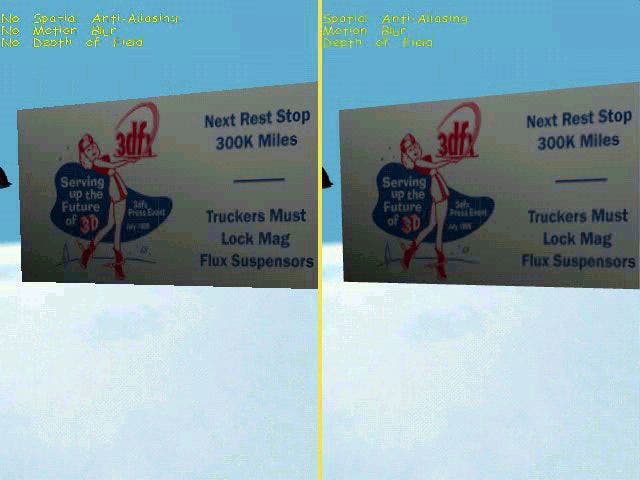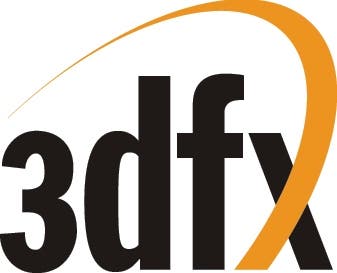Voodoo 5 5500 AGP
3dfx's flagship graphics card reviewed
- 3dfxPrice - £250
Voodoo Curse
3dfx have kept us waiting for over 18 months for their latest products. Probably nobody outside of 3dfx will ever know why it took them so long, but thankfully they have now been released. The real question is whether it was worth the wait, and will it push 3dfx back on to the top of the performance pile?
All of 3dfx's hard work has gone into producing the VSA-100 chip, formerly code-named Napalm. The VSA stands for Voodoo Scaleable Architecture, with the 100 probably indicating that it is the first generation of the chip - I wouldn't be surprised to see VSA-150 and 200 at some point...
So what does 3dfx's new chip offer? Well, it offers everything that was found on the old Voodoo 3, but also adds 32 bit colour rendering, Full Scene Anti-Aliasing, T-Buffer effects, and texture compression support through FXT1 and DXTC.
Perhaps the most interesting fact about the VSA-100 chip is that it is possible to put several chips on a single board to increase performance, and the Voodoo 5 5500 features two of them. This is reminiscent of running two Voodoo 2 boards in what was termed SLI, and seeing that such a rig offered the best performance of its day, it is no surprise that 3dfx have labelled their Voodoo 5 5500 as a "64Mb Dual-Chip SLI 2D/3D Accelerator".
Briefly, SLI (Scan Line Interleave) makes it possible to virtually double performance by simply adding an extra chip. The basic premise behind SLI is that one chip will draw the odd lines on the screen (1,3,5,7 etc) and the other will draw the even lines (2,4,6,8 etc). This leads to a doubling of the card's fill rate, which is directly linked to the maximum achievable frame rate, and hence in-game performance.
Beauty And The Beast
If there was a prize for the most ludicrous graphics card design, 3dfx would probably win it - the Voodoo 5 5500 is truly a monster.
With its two VSA-100 chips, 64Mb of memory, two fans, and a power supply which requires a seperate connector to fulfil its needs, the whole card measures 9 1/2 inches (or 24.5cm if you prefer). The last quarter of the board has a few hefty components on it that help to regulate the power supply to the board, most likely for the two fans that keep the VSA-100's cool.
On the hardware side of things, the two VSA-100 chips are supported by 64Mb of SDRAM. The clock speed of the board is 166MHz, which provides a fill rate of 333Mtexel/sec per chip. In the case of the 5500 board with its dual chips, this gives a total fill rate of 667Mtexel/sec.
This is quite impressive when compared to the 480Mtexels/sec of the original GeForce, but when compared to the new GeForce 2 GTS card's 1600Mtexels/sec it seems somewhat lacking. But then, that's why 3dfx are also creating a four chip Voodoo 5 6000...

Mr T Buffer
One of the major selling points of the VSA-100 is its support for full scene anti aliasing (FSAA). 3dfx utilise a two or four sample method, which causes the scene to be rendered either two or four times (according to how you set it up), with each rendered frame being slightly 'jittered' compared to the rest.
The idea is that by using a slightly offset group of images for the same frame, it is possible to lay them on top of each other to calculate the best anti-aliasing, reducing jagged lines and other rendering artifacts. There is one significant drawback to this though - it eats fill rate, and the card's performance can easily and quickly be consumed by the needs of FSAA.
Without FSAA the card's fill rate is 667Mtexels/sec, but with a two sample anti-alias this is effectively halved to 333Mtexels/sec, as you are rendering two seperate scenes and then combining them. Utilising four samples reduces this to a very disappointing 166Mtexels/sec.
As a result of this massive performance hit, 3dfx have said that FSAA is not something that players of 'twitch' style games such as Quake 3 Arena would want. But FSAA is appropriate for games where super-high frame rates are not required but visual detail is important, as 3dfx have shown with their many shots of Homeworld.
Full scene anti-aliasing is done in the T-buffer, which also allows for effects such as soft shadows, depth of field and motion blur, which 3dfx place under the broad title of "digital cinematic effects". Having seen demonstrations of the T-buffer effects one can't help but be impressed, although I'm not sure whether I actually want any of them in the games I play, especially if they're going to create a serious performance hit.
And, unlike FSAA, the other T-buffer effects must be added to games by the developers. As no other card currently supports them, they are unlikely to be widely used.
Performance
Performance wise the Voodoo 5 5500 is a little disappointing. It is certainly a great deal better than 3dfx's previous outings, but compared to today's fastest performers such as the GeForce 2 it is looking somewhat slow. Perhaps 3dfx will be able to do something about this with more efficient drivers.
One thing that is impressive is 3dfx's shiny new OpenGL ICD. In the past there was some trouble with games that relied on OpenGL, such as Quake 3 Arena, and it would take a little bit of tweaking to obtain acceptable results. Thankfully the new drivers are perfect and run without problems.
Conclusion
The Voodoo 5 5500 is an interesting product. It is certainly a world better than the Voodoo 3, and 32 bit colour is a rather overdue but gladly received addition.
Sadly though it is still suffering from sluggish performance (relatively speaking), and if you activate FSAA performance will only get worse. The card itself is quite a beast, but it looks tougher than it really is. At the current prices it is hard to justify spending so much on the Voodoo 5 5500 when one could purchase a GeForce 2 GTS based card for the same price, if not less.
I can certainly see the Voodoo 5 5500 finding some fans, especially amongst players of games that run better under 3dfx's old Glide API, such as Unreal Tournament, Starsiege Tribes and Quake 2. Likewise for games where fill rate isn't so important, such as 3D adventure, role-playing and strategy games, where the extra visual quality that the Voodoo 5 5500 and its full-scene anti-aliasing can offer will be welcome.
My biggest hope is that 3dfx will improve their drivers and lower prices to make the Voodoo 5 5500 even more competitive, as until they do it is a little under-performing and over-priced compared to other company's offerings.
-
Spring 2000 Graphics Card round-up

